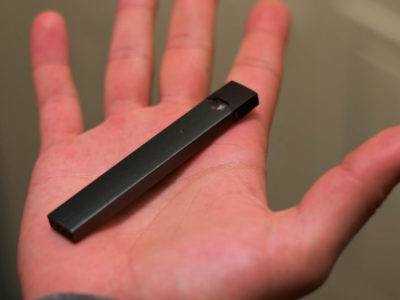I can remember everyone first started getting into Juuls in high school. It was as if I had turned around and suddenly everyone had one. At first, I was curious about this new device and why this overnight sensation was suddenly the newest teenage necessity.
I’ve tried it a couple times, and each time I can feel it. The sickeningly sweet scent of the flavoring, nicotine cutting through it like a knife. The addictiveness of it all at one time, and then a slightly dizzying feeling.
Each time I tried using a Juul, I could see how easily it would be to need it.
As the popularity of Juuling grew, so did the amount of people suffering the consequences of it. All of a sudden, I had friends who needed to Juul every day, and would need to go through a pod a day otherwise they would get crippling headaches and an all-over itching sensation. Even some of my closest friends became dependent on Juuls, including my 15-year-old brother and my 17-year-old sister.
One time, I dropped my sister off at Drivers Ed, and she was Juuling in the car before she went in. “So I can handle it,” she said. As an overpowering Crème Brulee smell filled the car, I knew why she was really doing it. Everyone else was.
I knew more people than I could count who would get nicotine poisoning from going through an entire pod in one night (equivalent to a pack of cigarettes) and then throw up continuously, trying to get the poison out of their bodies. And it was all I could do to sit back and wonder how people were still using these things, which were the electronic equivalent of a cigarette.
We had been conditioned against cigarettes since we were 10 years old, with commercials of lung cancer patients advising us against buying cigarettes, portraying the people who had the misfortune of getting their larynx removed and speaking to us through a stoma, always with the same message: “Don’t Smoke Cigarettes, Look at the Real Cost.” What I couldn’t understand was how no one else was making the connection.
I saw my great aunt Joyce dying of lung cancer and on an IV at 85, smoking a cigarette down to her last day. Many people don’t understand that e-cigarettes and traditional cigarettes contain almost the same number and amount of harmful chemicals. Juuls and other e-cigarette brands contain many of the same compounds as cigarettes, larger amounts of nicotine and a host of other chemicals. Juuls are equally as bad for you, if not worse.
These devices can very easily cause someone to be hooked on nicotine, and then as the addiction progresses, the user moves on to whatever is available in order to satisfy their addiction. At first, they seem relatively harmless, because people take the smoke in their mouths and do tricks with it like they’re toys or dollar-store magic tricks. Many people will bedazzle or decorate their Juuls, and vendors started selling vinyl Juul stickers online, like some kind of fashion statement.
Juuls are smaller and more accessible than other smoking methods, roughly the size of a led container for mechanical pencils. This along with the social normalization makes Juuls acceptable to pull it out at any given time.
In college, we live in this bubble where everything that happens in the real world can’t possibly affect us for a couple more years. “It’s not an addiction until you’re out of college,” someone dismissed me as I pointed out that they had gone through a pod in one day.
Tobacco companies use the guise of candy-like flavors and target teenagers through their advertising. What many people don’t realize is how harmful Nicotine can be to our brains at such a young age and how addictive they are, eventually leading to other tobacco products.
The disheartening truth is that although the anti-cigarette campaign was very successful, it wasn’t an anti-nicotine campaign. And people are still abusing tobacco products.



















